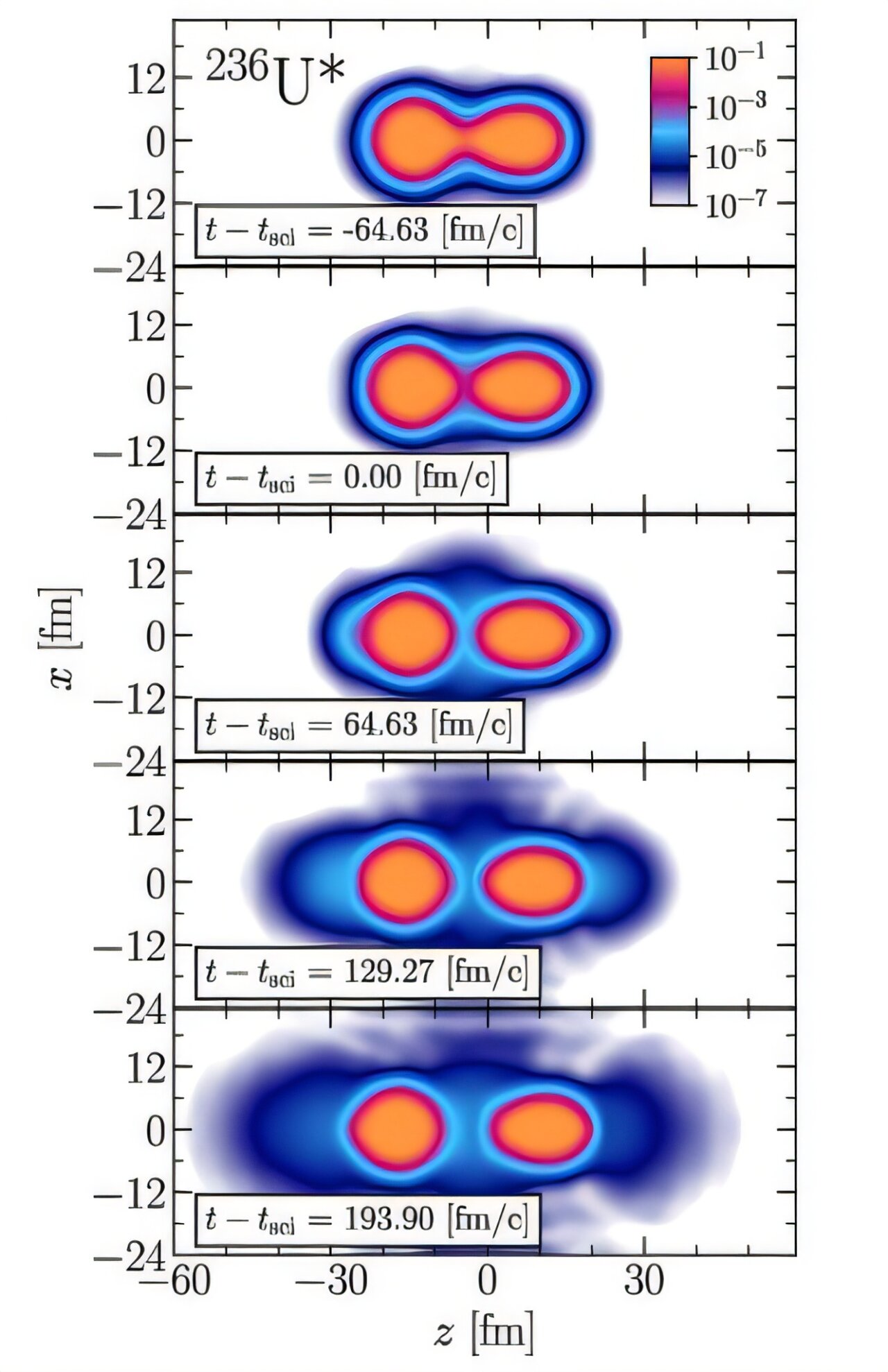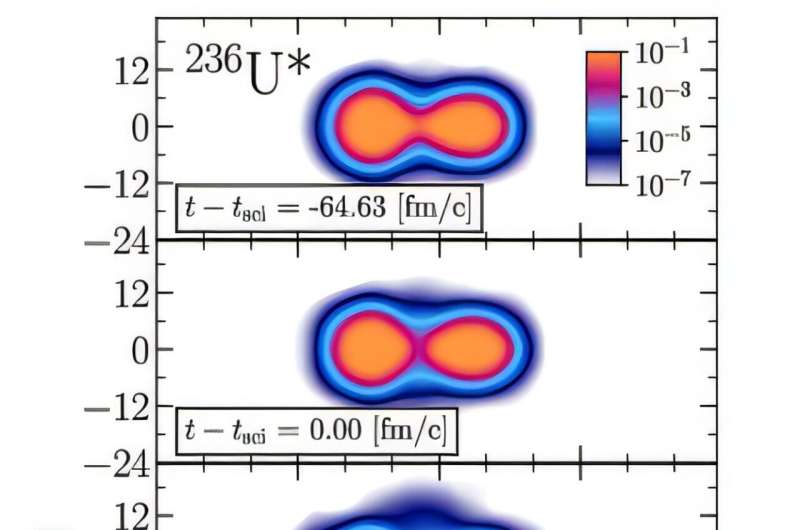

Nuclear fission—when the nucleus of an atom splits in two, releasing energy—may seem like a process that is fully understood. First discovered in 1939 and thoroughly studied ever since, fission is a constant factor in modern life, used in everything from nuclear medicine to power-generating nuclear reactors. However, it is a force of nature that still contains mysteries yet to be solved.
Researchers from the University of Washington, Seattle, or UW, and Los Alamos National Laboratory have used the Summit supercomputer at the Department of Energy’s Oak Ridge National Laboratory to answer one of fission’s biggest questions: What exactly happens during the nucleus’s “neck rupture” as it splits in two?
The resulting paper is published in the journal Physical Review Letters.
For the last 85 years, physicists have proposed a variety of theoretical models of the fission dynamics behind that neck rupture. The earliest analogy for fission is the “liquid drop” theory first posited by Lise Meitner and Otto Frisch, and then formulated by Niels Bohr and John Wheeler in 1939. It describes nuclei as behaving like spheres of charged fluid—when hit by a particle such as a neutron or proton, the nucleus splits into two fragments with a neck clinging between them. Once the neck stretches to its scission point and ruptures, it sends out “splatters” of particles, thereby releasing energy.
Scission neutrons—neutrons emitted during the final stages of nuclear fission, specifically at the moment when the nucleus undergoes scission and splits into two or more smaller nuclei—have been theorized to be among those particles emitted during neck rupture. However, their exact characteristics have been debated due to a lack of conclusive experimental evidence of scission neutrons’ existence.
But a team led by Aurel Bulgac, a physics professor at UW, has conducted the first fully microscopic, quantum many-body simulation of a nucleus’s neck rupture to produce the most accurate description yet of its fission dynamics. The team’s surprising results reveal a scission mechanism that is at odds with some previous assumptions.
“This is probably the most precise and most carefully obtained theoretical description of neck rupture, without any assumptions and simplification,” Bulgac said. “We have a very specific prediction, which until now didn’t exist. Previous theories were always based on, ‘Let’s assume that this is happening, and if it’s happening, then this probably is going to be seen.’ We didn’t do that. We simply put in the equations of motions known for many decades in nuclear physics with high precision, plus quantum mechanics, nothing else.”
The team—including LANL’s Ibrahim Abdurrahman and Ionel Stetcu and UW’s Matthew Kafker—produced several significant findings.
First, neck rupture is not a random process, as was previously argued in phenomenological models. Instead, a wrinkle in the nuclear density, where the neck is eventually formed and where the nucleus scissions, is determined a long time before the nucleus reaches scission.
Second, the proton neck completes its rupture earlier than the neutron neck does, resulting in the neck being mostly sustained by its neutrons just before the full rupture.
Third, the rupture is the fastest stage of fission dynamics, starting from the capture of the incident neutron and formation of the compound nucleus, until all fission fragments have been emitted.
Fourth, the neck-decay dynamics display a universality for asymmetric fission no matter the initial conditions. The proton and neutron neck ruptures are the same for all trajectories, unlike any other outcomes of the fission process.
Finally, the team’s results say that scission neutrons do indeed exist, and they carry a noticeable amount of the energy released in fission. Furthermore, the team’s simulation describes their angular distribution, or in which direction they’re emitted and with what energies. Previously, physicists were unsure of where to look for scission neutrons being emitted or how many to expect due to the presence of other neutrons.
“There were people saying they exist, and others saying they don’t exist. We see them, we don’t see them, and so on. Most experiments look for them in the direction of the motion of the fission fragments, and they couldn’t distinguish the scission neutrons there because most of them were thermal neutrons emitted by the hot fragments,” Bulgac said.
The team’s simulation found that the scission neutrons are emitted in two different, distinct modes. At the moment of scission, neutrons are emitted sideways. As the nucleus’s two fragments move horizontally, neutrons are emitted in the plane perpendicular to the horizontal axis. At the same time, when the neck snaps, it sends a wave of matter to the nucleus that emerges on the other side. This forms two more clouds coming from the “noses” of the fission fragments.
“After we put everything together and ran the simulation, we found out certain things that were totally unexpected: neutrons coming out sideways and then in the direction of the moving fragments. These types of distinct spectra are something that none of the earlier models predicted. Moreover, they are very high energy, so they should have properties very distinct from thermal neutrons,” Bulgac said.
The team’s numerical simulation required the entirety of Summit for almost 1 million node-hours. Each run required about 15 hours of elapsed time for three different nuclei—uranium-238, plutonium‑240 and californium-252—with various initial conditions. Summit, which is managed by the Oak Ridge Leadership Computing Facility, a DOE Office of Science user facility at ORNL, is scheduled for decommissioning in November and has been superseded by the OLCF’s exascale-class supercomputer, Frontier.
The team’s calculations were made using a mathematical framework Bulgac began developing in the early 2000s based on Walter Kohn and Pierre Hohenberg’s density functional theory, a quantum mechanical modeling method for investigating superfluid nuclei and quantized vortices in neutron star crust and cold atom systems.
Rather than having to calculate the precise position of every particle in a many-body system, density functional theory focuses on the distribution of particles in space, which only requires three coordinates. Using the Schrodinger equation, for example, would require around 30 parameters and many assumptions to calculate the particles’ full wave function. Bulgac’s nuclear energy density function uses eight parameters—and still required the full power of leadership computing.
“An absolutely crucial tool was the use of supercomputers at Oak Ridge, starting with Jaguar and Titan, then Summit. Without them, all this would have been impossible. Absolutely impossible. Even now, we are moving some of the calculations to Frontier so we can look further. But even Frontier is not enough, and we will probably need bigger supercomputers at one point to investigate finer details,” Bulgac said.
The team’s next step is to see whether experiments will agree with their findings. Bulgac said he has already had discussions with experimentalists about their ideas to test the paper’s predictions in the lab.
“We used precise values for the parameters that describe this phenomenon—and nothing else. And these are the results we got. Now, if they are not true, then there is a very big question: what’s wrong with the theory?” Bulgac said.
“At the moment, it’s very hard to see what would be wrong, but we have to wait and see. If you make a prediction, it is confirmed or not confirmed, and then you must look and see. This is how physics proceeds.”
More information:
Ibrahim Abdurrahman et al, Neck Rupture and Scission Neutrons in Nuclear Fission, Physical Review Letters (2024). DOI: 10.1103/PhysRevLett.132.242501. On arXiv: DOI: 10.48550/arxiv.2307.13132
Provided by
Oak Ridge National Laboratory
Citation:
Tracking down nuclear fission’s elusive scission neutron with a supercomputer (2024, October 23)
retrieved 23 October 2024
from https://phys.org/news/2024-10-tracking-nuclear-fission-elusive-scission.html
This document is subject to copyright. Apart from any fair dealing for the purpose of private study or research, no
part may be reproduced without the written permission. The content is provided for information purposes only.